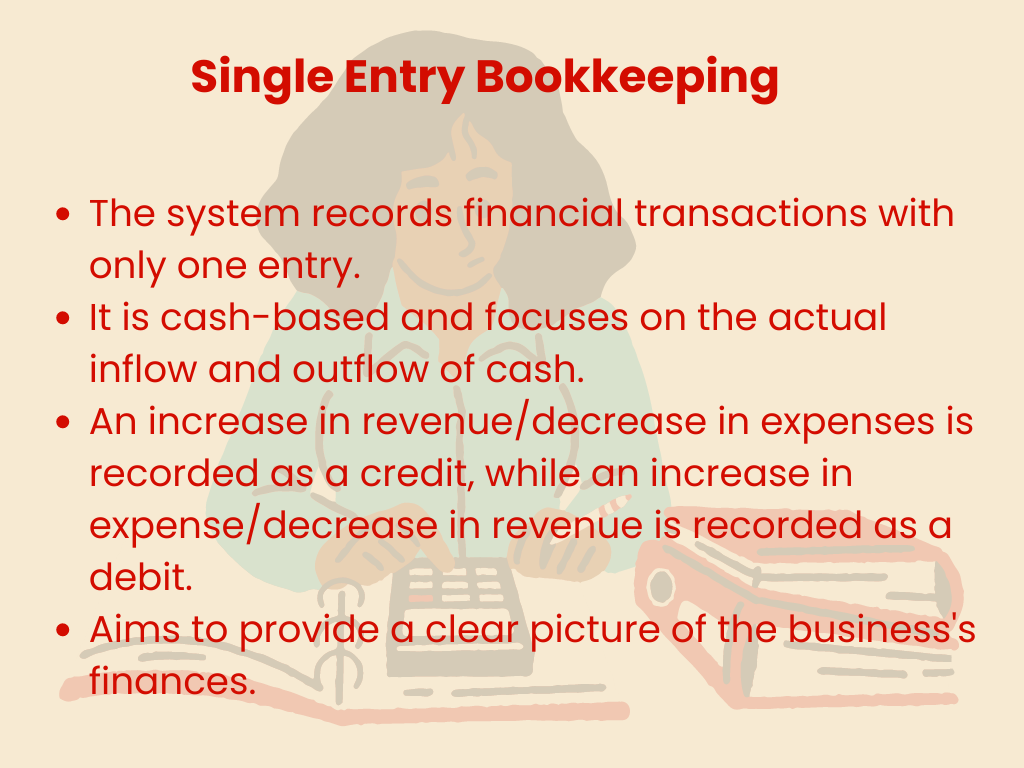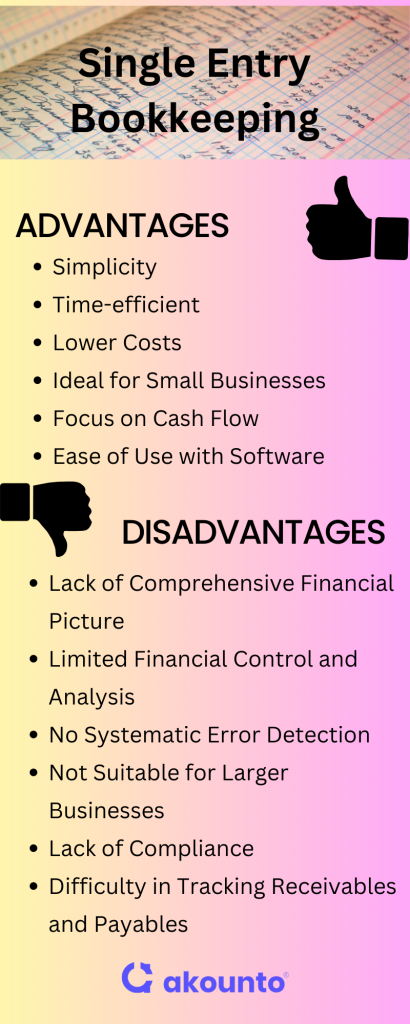Defining Single-entry Bookkeeping System
Single-entry bookkeeping is favored by small firms and freelancers, where each financial transaction is recorded with only one entry.
[ez-toc]
It is a simple, straightforward method to record transactions that contrasts with the double-entry bookkeeping system, which records two entries for each transaction—a debit entry and a credit entry.
The single-entry accounting focuses primarily on the inflow and outflow of cash, akin to a check register. This method records transactions in a cash book, which typically includes receipts, payments, and balances columns.

The simplicity of the single-entry systems make it an ideal choice for small business owners, freelancers, and sole proprietors who have fewer transactions to track compared to larger entities.
The single-entry bookkeeping system operates on the premise of recording business transactions primarily as either income or expenses. The primary goal is maintaining a record of all financial transactions to provide a clear picture of the business’s financial state.
Features
Several distinctive features characterize single-entry bookkeeping.
- Records only cash transactions involving credit or accounts receivable and accounts payable are often omitted or inadequately tracked.
- This system is simple and less time-consuming, as it involves recording fewer details than a double-entry accounting system. The single-entry system does not provide a complete financial picture or error detection and error correction system like the double-entry accounting system.
- Income and expenses are recorded as they happen, which aligns with the cash basis method. This contrasts the accrual accounting method, where income and expenses are recorded when earned or incurred, irrespective of when the money is exchanged. Click here to read about Matching Principle.
Principle of Single Entry Bookkeeping
The single-entry bookkeeping system is primarily cash-based, focusing on the actual flow of cash rather than tracking assets, liabilities, and capital.
Every transaction affects only one account. This starkly contrasts the double-entry system, where each transaction impacts two accounts, maintaining a balance through the basic accounting equation (Assets = Liabilities + Equity).
Despite the name, the single-entry system also involves debits and credits, albeit in a much simpler format. However, the rules of debit and credit in this system differ from those in the double-entry accounting. In single-entry bookkeeping:
- An increase in revenue or decrease in expenses is recorded as a credit.
- An increase in expense or a decrease in revenue is recorded as a debit.
The cash book is the primary tool for maintaining records in the single-entry system. This ledger includes separate columns for income (credits) and expenses (debits), providing a simple, organized overview of the business’s cash flow.
While single-entry bookkeeping is fundamentally a cash basis accounting system, it can also accommodate basic accruals, such as accounts receivable and accounts payable, albeit less systematically than the double-entry system.
Use by Small Businesses
Small businesses often prefer the single-entry bookkeeping system due to its simplicity and straightforward approach. Small enterprises have fewer transactions and less complex financial operations.
The business’s finances are primarily tracked through a detailed cash book in single-entry accounting. Transactions recorded include cash sales, expenses, and purchases, among others.
A small business owner needs to understand the limitations of the single-entry accounting. While it offers a simple way to track cash transactions, it does not provide a comprehensive financial picture and does not automatically generate an income statement or balance sheet.
Moreover, this system does not lend itself well to creating a trial balance, a tool that checks the arithmetic accuracy of the books. In a double-entry accounting system, the trial balance ensures that total debits equal total credits.
In a single-entry system, this form of error checking is impossible without a consistent record of both debits and credits.
Modern accounting software can bridge the gap between the simplicity of single-entry bookkeeping and the robustness of double-entry systems. Such software can automatically generate income statements and balance sheets from single-entry data, offering small business owners a comprehensive view of their financial status.
Cash Book
In the single-entry accounting system, the rules of recording transactions are quite straightforward. Every transaction, income, or expense is registered once in a primary document known as the cash book.
The cash book operates as the main ledger of this accounting system, acting as the repository for all financial transactions. Credit entries are made on one side of the cash book, documenting all incoming cash. Conversely, the other side captures debit entries, recording all cash outflows.
A vital rule in single-entry bookkeeping is the contemporaneous recording of transactions. A financial transaction should be logged in the cash book as soon as it occurs. This real-time recording practice ensures that the ledger always mirrors the actual cash position of the business.
The correct amounts must be recorded, and the entries should correspond with invoice numbers or bank statements for verification. A consistent, error-free recording is vital to ensure the cash book accurately reflects the business’s financial status for the given accounting period.
The cash book in a single-entry system does more than just record transactions; it also categorizes them. For instance, cash inflows could be categorized as sales, loan receipts, or asset sales, while outflows might be classified as purchases, salaries, or loan repayments. This recording method allows for a better understanding of where the business’s money is coming from and where it’s going.
Example
Assume that you’re a small business owner who has reported the following transactions in May 2023:
- May 1: Started the business with a capital of $10,000.
- May 2: Purchased office supplies for $200 in cash.
- May 4: Made cash sales of $1,500.
- May 8: Paid utilities bill of $100.
- May 10: Purchased inventory worth $500 on credit.
- May 15: Made cash sales of $2,000.
- May 20: Paid for the inventory purchased on credit.
- May 22: Paid salaries of $800 to employees.
- May 30: Made cash sales of $2,500.
Record these transactions in the cash book under the single-entry system.
| Date | Particulars | Debit ($) | Credit ($) | Balance ($) |
| May 1 | Capital | – | 10,000 | 10,000 |
| May 2 | Office Supplies | 200 | – | 9,800 |
| May 4 | Cash Sales | – | 1,500 | 11,300 |
| May 8 | Utilities | 100 | – | 11,200 |
| May 10 | Inventory (on credit) | – | – | 11,200 |
| May 15 | Cash Sales | – | 2,000 | 13,200 |
| May 20 | Payment for inventory | 500 | – | 12,700 |
| May 22 | Salaries | 800 | – | 11,900 |
| May 30 | Cash Sales | – | 2,500 | 14,400 |
This example demonstrates how the single-entry system provides a straightforward view of cash inflows and outflows in a business. In the single-entry accounting system, only cash transactions are recorded. Thus, transaction 5 (Purchased inventory worth $500 on credit) does not affect the cash book.
Advantages
- Simplicity: Single-entry bookkeeping is straightforward to understand, even for individuals without accounting backgrounds. The focus is on cash flow, clearly showing money coming in and going out.
- Time-efficient: As it requires only one entry for each transaction, this system is quicker to maintain than double-entry accounting. This efficiency can particularly benefit small business owners who manage their books.
- Lower Costs: Due to its simplicity, single-entry bookkeeping often requires less time and fewer resources. This can result in lower accounting costs for businesses.
- Ideal for Small Businesses: For small enterprises, freelancers, or startups with a low volume of transactions, the single entry system is often sufficient to meet their needs.
- Focus on Cash Flow: Single-entry bookkeeping is primarily concerned with cash transactions, providing a clear picture of a business’s cash flow.
- Ease of Use with Software: Many bookkeeping software packages, even those designed for double-entry bookkeeping, can easily accommodate single-entry bookkeeping.

Disadvantages
- Lack of Comprehensive Financial Picture: Single-entry bookkeeping primarily tracks cash flow and does not record all aspects of a transaction. This can make it difficult to completely understand a business’s financial health.
- Limited Financial Control and Analysis: This system doesn’t provide a balanced view of debits and credits, making it challenging to perform comprehensive financial analysis and maintain control over financial operations.
- No Systematic Error Detection: Unlike double-entry bookkeeping, the single-entry system has no built-in mechanism for detecting recording errors.
- Not Suitable for Larger Businesses: Businesses with a high volume of transactions, multiple departments, or complex operations may find the single entry system insufficient for their needs.
- Lack of Compliance: The single-entry system may not meet the regulatory requirements for financial reporting in some jurisdictions or industries.
- Difficulty in Tracking Receivables and Payables: Single-entry bookkeeping doesn’t track accounts receivable and accounts payable as effectively as the double-entry system, which can lead to issues with cash flow management.
Compliance Challenges
- Internal Revenue Service (IRS): In the United States, the IRS needs businesses to keep accurate records of income and expenses. While a single-entry system can keep track of these elements, it may not provide the detail required for larger businesses or those with complex transactions.
- Securities and Exchange Commission (SEC): Public companies under the jurisdiction of the SEC are required to follow Generally Accepted Accounting Principles (GAAP), which mandate the use of a double-entry accounting system. Single-entry bookkeeping does not meet these standards.
- International Financial Reporting Standards (IFRS): For businesses operating internationally, IFRS requires detailed financial statements that may not be achievable with a single-entry accounting system.
- Limited Audit Trail: Single-entry bookkeeping doesn’t provide a complete audit trail, which can complicate audits and potentially raise compliance issues.
- Difficulty Demonstrating Solvency: If a business must demonstrate its solvency, the lack of a comprehensive balance sheet in single-entry bookkeeping can be a disadvantage.
- Lack of Clarity for Creditors and Investors: External stakeholders such as creditors, investors, or potential buyers might require detailed financial records that show a complete picture of the business’s financial health.
Other Recording Systems in Accounting
- Double-entry Bookkeeping System: The double-entry system records each transaction in at least two accounts – a debit and a credit in another. This system adheres to the basic accounting equation: Assets = Liabilities + Equity.
- Accrual Accounting: In accrual accounting, revenues and expenses are recorded when earned or incurred, irrespective of when the cash is received or paid.
- Cash Basis Accounting: This system records income when cash is received and expenses are paid.
- Hybrid Accounting: This system combines accrual and cash basis elements. It allows businesses to record some transactions using the cash basis and others using the accrual basis.
Conclusion
While the single-entry systems can efficiently serve small businesses’ needs, bigger organizations rely on more complex systems for error-free transactions. Maintaining accurate business finances and ledger accounts is key to a successful entry bookkeeping system, regardless of the method.
Accounting software like Akounto lets small businesses choose single entry system and when they grow and scaleup, they can choose to switch to double entry accounting system. Visit Akounto’s website to know more.




